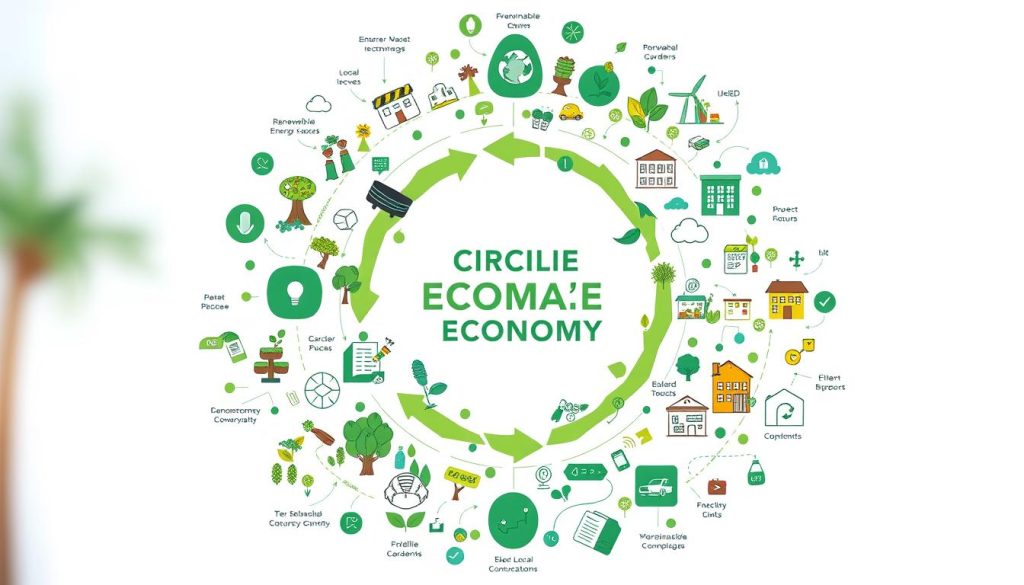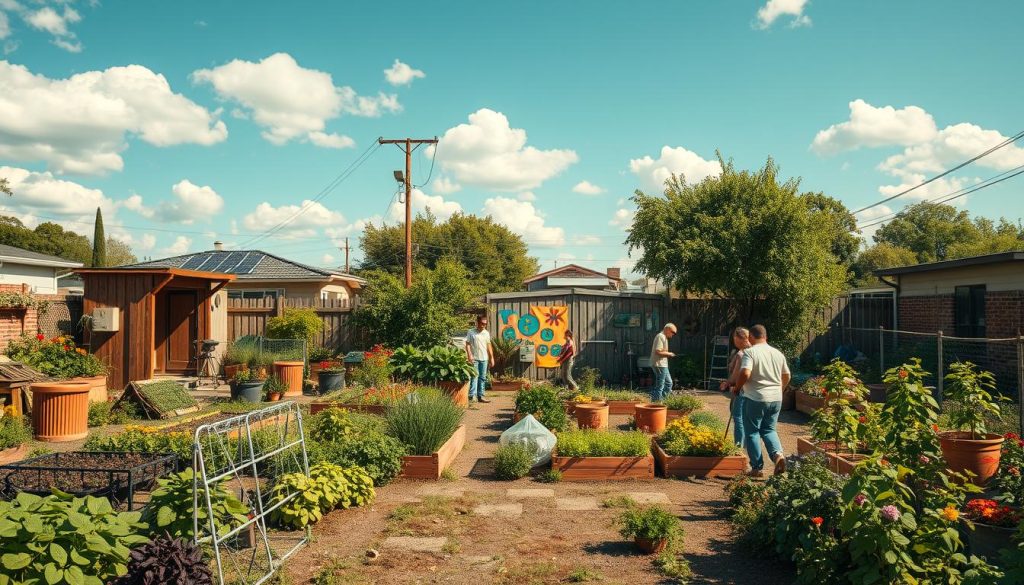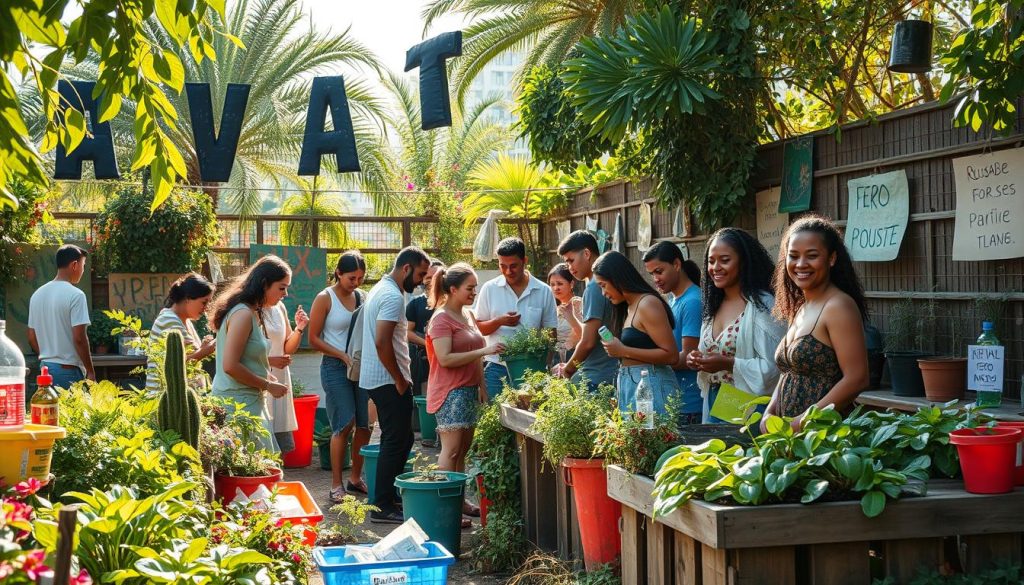I’m excited to share my journey towards creating a zero waste community. It’s a path that combines sustainable living with environmental stewardship. We can all walk this path together. In this article, I’ll guide you through the steps to build a thriving, eco-conscious society right where you live.
We’ll explore the core concepts of zero waste. We’ll discover practical strategies for daily life. And we’ll learn how to inspire others.
I’ll show you how to work with local businesses. We’ll overcome challenges together. And we’ll measure our progress.
By the end, you’ll have the tools to make a real difference in your neighborhood and beyond. Let’s embark on this green adventure. Let’s create a cleaner, more sustainable future for ourselves and generations to come. Are you ready to join me in building a zero waste community? Let’s get started!
Understanding the Concept of a Zero Waste Community
I’m excited to explore zero waste communities with you. These places lead the way in living lightly and reducing waste. Let’s see what makes them special and why they matter.
Defining zero waste and its importance
Zero waste means sending nothing to landfills or incinerators. It’s about changing how we view things. We aim to use less, reuse more, and recycle everything we can. This helps our planet and saves resources for the future.
Key principles of a zero waste lifestyle
Living zero waste involves some key rules:
- Refuse what you don’t need
- Reduce what you do use
- Reuse items as much as possible
- Recycle what can’t be reused
- Rot (compost) the rest
Benefits of creating a zero waste community
Creating a zero waste community has many benefits:
| Environmental Benefits | Economic Benefits | Social Benefits |
|---|---|---|
| Reduced landfill waste | Lower waste management costs | Stronger community bonds |
| Decreased pollution | Job creation in recycling industries | Improved public health |
| Conservation of natural resources | Savings from reuse and repair | Increased environmental awareness |
By following these principles, we can build sustainable communities. Together, we can greatly improve our planet’s health and our own well-being.
Getting Started: Laying the Foundation for a Zero Waste Community
I’m excited to share how we can start building a zero waste community. It’s a journey that requires dedication, but the rewards are immense. Let’s dive into the practical steps we can take to make our vision a reality.
First, we need to set clear goals. I suggest focusing on resource conservation and promoting conscious consumption. These objectives align perfectly with the circular economy model we’re aiming to create.
Next, it’s crucial to identify key stakeholders. This includes local government officials, business owners, and community leaders. Their support will be invaluable in implementing our zero waste initiatives.
- Develop a roadmap outlining specific actions and timelines
- Create a community engagement plan to boost participation
- Establish metrics to track progress towards our goals
Community engagement is the heart of our efforts. I recommend hosting town hall meetings, creating online forums, and organizing volunteer groups. These activities will help spread awareness and foster a sense of collective responsibility.
| Action | Timeline | Expected Outcome |
|---|---|---|
| Conduct waste audit | Month 1-2 | Baseline data for improvement |
| Launch education campaign | Month 3-4 | Increased awareness |
| Implement recycling program | Month 5-6 | Reduced landfill waste |
Remember, building a zero waste community is a gradual process. Let’s celebrate small victories along the way and stay committed to our long-term vision of a sustainable, circular economy.
Educating and Inspiring Community Members
I think education is crucial for a strong zero waste community. Sharing knowledge and inspiring others can lead to big changes. Let’s look at ways to spread awareness and encourage eco-friendly actions.
Organizing Workshops and Seminars
Hands-on workshops are perfect for teaching real skills. I’ve seen how composting demos, DIY cleaning product classes, and repair cafes spark interest in caring for the environment. Seminars with local experts can delve into topics like cutting down food waste or building a circular economy.
Utilizing Social Media and Online Platforms
Social media is a great tool for reaching more people. I make fun content like short videos on upcycling or infographics about reducing waste. Online groups let us share tips, celebrate successes, and support each other’s green living paths.
Creating Informative Resources and Guides
Good guides make eco-friendly living easier to follow. I create simple resources on things like:
- Starting a zero waste kitchen
- Eco-friendly gift wrapping ideas
- How to shop package-free
- Local recycling guidelines
These resources help community members make small changes that make a big difference. By focusing on education and inspiration, we can build a culture of caring for the environment. Together, we can work towards a zero waste future.
Implementing Waste Reduction Strategies in Daily Life
Starting a low-impact lifestyle is all about making small changes. By focusing on reducing waste and embracing minimalism, we can make a big impact. Let’s look at some easy ways to cut down on waste every day.
When I shop, I always carry reusable bags and containers. This simple habit helps me avoid single-use plastics and unnecessary packaging. Buying in bulk also reduces packaging waste and saves money.
In the kitchen, I’ve learned to be creative with leftovers and food scraps. Composting is a big part of my waste reduction plan. It’s incredible how much kitchen waste can become nutrient-rich soil for gardens!
- Use cloth napkins instead of paper
- Opt for reusable water bottles and coffee cups
- Choose products with minimal or recyclable packaging
- Repair items instead of replacing them
Personal care is another area where I’ve made big changes. I’ve switched to bar soap, shampoo bars, and reusable razors. These changes not only cut down on plastic waste but also make my bathroom routine simpler, fitting my minimalist lifestyle.
By adopting these strategies, I’ve seen a big drop in my household waste. It’s fulfilling to see how small changes can lead to a more sustainable and rewarding life.
Fostering Collaboration with Local Businesses and Organizations
Building a zero waste community needs teamwork. I’ve seen that working with local businesses, schools, and government agencies is key. Together, we can make our community more sustainable and move towards a circular economy.
Partnering with eco-friendly businesses
Local eco-friendly businesses are important allies in our zero waste journey. I’ve seen how these partnerships lead to new ideas. For example, a nearby grocery store now has bulk food stations, cutting down on packaging waste. Another shop offers refill programs for cleaning products, reducing plastic bottle use.
Engaging with schools and educational institutions
Schools are vital in teaching future environmental leaders. I’ve worked with local schools to start recycling programs and zero waste challenges. These efforts not only reduce waste but also teach students about living sustainably.
Collaborating with local government and environmental agencies
Government support is crucial for big changes. I’ve found that working with city officials and environmental agencies helps us achieve our zero waste goals. We’ve added curbside composting and expanded recycling, making it easier for people to waste less.
Through these collaborations, we’re building a strong base for a circular economy in our community. Each partnership brings us closer to a sustainable future.
Creating a Circular Economy Within Your Community

I’m excited to share how we can build a circular economy in our community. This approach is key to saving resources and being eco-friendly. In a circular economy, we use materials well and keep them in use for as long as possible.
Let’s look at some ways to make this happen:
- Encourage local businesses to adopt reusable packaging
- Set up community repair workshops for electronics and appliances
- Create a neighborhood tool-sharing program
- Establish a compost collection service for food waste
These initiatives help us move away from the traditional “take-make-waste” model. Instead, we focus on reusing, repairing, and recycling. This shift not only reduces waste but also creates new job opportunities in our community.
| Initiative | Goal | Current Status |
|---|---|---|
| Reusable packaging | 50% of local businesses | 25% participating |
| Repair workshops | Monthly events | Quarterly events |
| Tool-sharing program | 100 members | 45 members |
| Compost collection | 500 households | 200 households |
By working together, we can create a thriving circular economy that benefits our community and the environment. Let’s embrace these eco-friendly practices and make a lasting impact!
Overcoming Challenges in Building a Zero Waste Community
Creating a zero waste community is a big challenge. I’ve faced many obstacles on my path to reduce waste and live sustainably. Let’s look at common challenges and how to beat them.
Addressing Common Obstacles and Misconceptions
Many think living zero waste is too pricey or takes too much time. But, it can actually save you money. Using reusable items, buying in bulk, and using less can cut down costs.
Developing Strategies for Long-Term Commitment
Staying motivated is key for lasting success. I set goals and track my progress. This helps me stay on track. Being part of local green groups also gives me support and new ideas.
Celebrating Small Victories and Progress
It’s important to celebrate every win, no matter how small. I mark down each time I reduce waste or find new ways to reuse things. These wins keep me going and encourage others in my community.
| Challenge | Strategy | Outcome |
|---|---|---|
| Cost perception | Track savings from reusables | Reduced expenses |
| Lack of motivation | Set achievable goals | Sustained commitment |
| Limited community support | Join local sustainability groups | Increased engagement |
By tackling these challenges, my community has made big strides in reducing waste. Remember, every step towards a greener life helps us all.
Innovative Solutions for Waste Reduction and Resource Conservation

I’m excited to share some cutting-edge approaches that are changing the game for waste reduction and resource conservation in zero waste communities. These innovative solutions are not only good for the planet but also bring people together and spark creativity.
One of my favorite ideas is the repair cafe concept. These community-driven workshops let skilled volunteers help people fix broken items, from electronics to clothing. It’s a win-win, reducing waste and sharing valuable skills within the community.
Tool libraries are another great idea for saving resources. Instead of everyone owning tools they rarely use, people can borrow what they need. This approach cuts down on waste and saves space, encouraging a shared resource mindset.
Upcycling initiatives have really taken off in zero waste communities. Local artists and crafters turn old materials into beautiful, useful items. This creative way of looking at waste inspires others to see the potential in discarded items.
| Initiative | Benefits | Community Impact |
|---|---|---|
| Repair Cafes | Extends product life, reduces waste | Builds skills, fosters community connections |
| Tool Libraries | Reduces individual consumption | Promotes sharing economy, saves money |
| Upcycling Projects | Transforms waste into valuable items | Inspires creativity, supports local artisans |
These innovative solutions show that with creativity and teamwork, we can create thriving zero waste communities. We can conserve resources and embrace eco-friendly practices along the way.
Measuring Success: Tracking Progress and Setting Goals
Measuring success is key for any zero waste community. By tracking our progress and setting clear goals, we can see if our efforts are working. Let’s look at some ways to measure our environmental stewardship.
First, we should set baseline metrics. This means measuring how much waste we generate now. With this info, we can aim for realistic waste reduction goals.
Then, we need a timeline for our goals. Short-term goals might be to cut single-use plastics by 50% in six months. Long-term goals could aim for a 90% reduction in landfill waste in five years.
To track our progress well, we should use certain key performance indicators:
| Metric | Description | Target |
|---|---|---|
| Waste Diversion Rate | Percentage of waste diverted from landfills | Increase by 5% annually |
| Recycling Participation | Number of households actively recycling | Reach 95% community-wide |
| Composting Adoption | Percentage of residents composting at home | Achieve 50% adoption rate |
| Single-Use Plastic Reduction | Decrease in single-use plastic consumption | Reduce by 75% in 3 years |
By checking these metrics often, we can see what needs work and celebrate our wins. This data-driven method keeps us on track and motivated towards a zero waste community.
Expanding Your Impact: Connecting with Other Zero Waste Communities

Connecting with other zero waste communities is a powerful way to make a bigger impact. By networking and sharing knowledge, we can move faster towards a sustainable future. Let’s look at some ways to reach out and join forces with others who share our goals.
Online platforms are a great way to connect. I’ve joined several social media groups focused on zero waste living. These groups let me share ideas and learn from others. They also host events and challenges that keep us motivated.
Going to conferences and workshops is another excellent way to meet like-minded people. These events teach us new ways to reduce waste and let us meet experts. I’ve found valuable connections that have led to new projects and resources.
| Connection Method | Benefits | Examples |
|---|---|---|
| Online Platforms | Idea exchange, global reach | Facebook groups, Reddit communities |
| Conferences | Networking, expert insights | Zero Waste Conference, Plastic Free July Summit |
| Local Meetups | Community building, hands-on learning | Repair cafes, swap events |
Getting involved in regional or national zero waste initiatives has opened my eyes. These big movements show us that our small actions add up. By joining these initiatives, we get more resources, support, and a chance to share our stories.
Conclusion: Embracing a Sustainable Future Together
Building a zero waste community is an exciting journey. It needs dedication and teamwork. We’ve looked at how to create a sustainable living space. This includes understanding key principles and using practical strategies to reduce waste.
I believe we can make a big difference together. Every small action helps, like composting at home or supporting local green businesses. These actions are key to a thriving zero waste community.
Sustainable living is crucial for our planet’s future. By adopting these practices, we reduce our environmental impact and build a healthier community. I urge you to start today. Begin with small steps, stay committed, and inspire others to join the zero waste movement. Together, we can create a cleaner, greener future for all.

